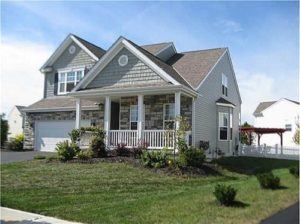What can you do with $257,989 in housing funds? In most Ohio markets, it may buy a comfortable home. In Lima, Ohio, it runs an entire housing program! The City of Lima is the third smallest HOME Investment Partnerships Program (HOME) entitlement community in Ohio. Yet, Lima is attracting attention with the announcement of a 15 million-dollar historic bank building renovation, which will produce 47 apartments and 3 floors of office and retail. Ten of the apartment units will be market rate. This project is in addition to running a popular housing down payment assistance program and providing home repair loans. How can so little funding produce so much? Several strategies are needed for big results, and to make local needs mesh with limited resources and daunting regulatory requirements.
HOME Rules: “That word, I do not think it means what you think it means”
This quote by Inigo Montoya, portrayed by Mandy Patinkin, in the 1987 film “The Princess Bride”, often comes to mind when approaching the daunting United States Department of Housing and Urban Development (HUD) regulatory environment, as small communities interpret the basics of HOME obligation and compliance. Communities need to seriously consider and have clarity on project eligibility, periods of monitoring, resident income limits and the additional reporting required to undertake HOME funded projects. An underestimated step in working with HOME funds is the time and staff it takes to create and administer a 5-year consolidated plan, annual plans, annual performance reports, fair housing plans, Davis- Bacon reporting and Section 3 compliance. Input of performance data into the Integrated Disbursement and Information System (IDIS) is alone estimated to average over 25 hours. This is not including multiple hours spent in data collection, client outreach, public hearings, and additional report compliance. With a 10% cap on administrative costs within the grant, administrative investment beyond HOME funds is needed.
The Strategy: Make Friends
Thorough research of current requirements via the HUD Exchange website and
consultation with local HUD field  representatives is needed before committing to any project. Connecting with HOME funded communities of similar sized HOME allocation is extremely valuable, as their victories and mistakes can help guide you. Local elected officials will need to be educated in clear terms on the long term obligations and current restrictions on HOME funds, so expectations and commitments are realistic. Work with your Finance Department early on to establish Government Accounting Standards Board (GASB) accounting systems that mirror HOME requirements. Sharing the workload with other departments and agencies is possible if they can accommodate the HOME requirements. Lima has benefited from working with Lima Allen County Regional Planning Commission, The Ohio State University and Lima Allen County Housing Consortium in demographic and housing data collection for required reports, as they had projects that also benefitted from the information. The Ohio Conference of Community Development is probably the best membership investment made by Ohio CDBG/ HOME communities for practical and up to date information from HUD and peers.
representatives is needed before committing to any project. Connecting with HOME funded communities of similar sized HOME allocation is extremely valuable, as their victories and mistakes can help guide you. Local elected officials will need to be educated in clear terms on the long term obligations and current restrictions on HOME funds, so expectations and commitments are realistic. Work with your Finance Department early on to establish Government Accounting Standards Board (GASB) accounting systems that mirror HOME requirements. Sharing the workload with other departments and agencies is possible if they can accommodate the HOME requirements. Lima has benefited from working with Lima Allen County Regional Planning Commission, The Ohio State University and Lima Allen County Housing Consortium in demographic and housing data collection for required reports, as they had projects that also benefitted from the information. The Ohio Conference of Community Development is probably the best membership investment made by Ohio CDBG/ HOME communities for practical and up to date information from HUD and peers.
Project Selection: Go Big or Don’t Go HOME
A tough choice in small communities is whether to do community improvement through many individual projects, or to create impact through consolidation of funding into fewer large projects. HOME projects are not easy, especially if staff time is limited for monitoring and certification. The adoption of the 2013 HOME Rule, and changes to project environmental review standards, have added to this challenge. National housing trends have shifted away from single family housing development to the need for multifamily housing by Baby boomers and millennials. Urban redevelopment is a priority even in small towns. Repair programs have trouble finding eligible users, as home owners must bring the entire housing up to code, which often triggers unrecoverable expense through lead remediation requirements. These factors have redirected HOME funds away from a direct benefit to individual home owners through small scattered site activities, to larger developments that can be monitored as a single project. Lima has attempted to balance both needs by restructuring its programs.
The Strategy: Divide the Pie, But Save a Piece
Through partnership with local mortgage bankers and realtors, an informed estimate of the number of eligible HOME funded home repairs or potential first time home buyers can be developed. This can enhance available census data projections with real-time local data. Engaging these professionals in dialogue also involves them in the housing solution. Many banks are
home repairs or potential first time home buyers can be developed. This can enhance available census data projections with real-time local data. Engaging these professionals in dialogue also involves them in the housing solution. Many banks are
offering their own incentive programs for repair and down payment, as expansions of their community reinvestment obligations. Connecting low income persons with service providers, through city sponsored home ownership training and housing fairs, are good investments and cost effective supplements to direct HOME loans. HOME payment assistance and repair loans are still utilized, but the program has been refocused to layering HOME funds with loans from banks and other local service programs, such as weatherization, elder repair services and Department of Health lead abatement programs. With these partnerships, Lima stretched $54,600 in HOME investment into down payment assistance for 7 homes. Keeping the smaller “slice” of HOME funds for small projects, leaves a larger slice to be invested in a unified project. This larger project may serve more than one family or individual in a creative way, in order to address multiple needs. Historic restoration, downtown development, market rate units and economic revitalization, can all be leveraged by inclusion of HOME units in a selected project. Careful analysis is needed by the community to find the maximum benefit for the limited dollars HOME may provide.
Project Funding: Leveraging, Layering and Layaway
Laying away a “slice” of HOME funds over a two-year period, before commitment to a large project, is a way for communities with lesser allocations to support a larger project. This requires long term planning with HUD and local officials, up to 3 or more years in advance, to begin identification and selection of potential projects. Annual HOME plans must identify the intent to commit funds within the second year of HOME award, and be clear on the process for identifying a HOME eligible project. HOME funds provide a significant boost to many project funding packages, even if the dollar amounts are small. The commitment of local dollars to a project signals community commitment, as desired by funders. Lima committed $500,000 that had been set aside over a period of years toward the $15 million-dollar 43 Town Square project. The leverage it provided was critical in scoring maximum points for Low Income Housing Tax Credits (HTC) from the Ohio Housing Finance Agency. Inclusion of HOME funds are powerful, and gives the community a partnership role, allowing them to be clear on what both HOME and the local community will accept in project design. The greatest allowable investment of HOME funds is established by maximum cost per unit guidelines. A request to the developer for additional investment of other funds is not unreasonable. The days of depending on HOME investment as the primary project funding source are over, as funding layering is a stronger indication of the developer’s ability to manage and sustain a project. Negotiating additional low income residential units, market rate units, building amenities and/or mixed use space is a way to maximize the HOME commitment.
The Strategy: Start Early, Consult Often
Long term planning is often not a strength of small communities, but being able to see
the future has become a necessity for HOME fund use. Identifying population, housing, and income trends, as part of housing planning may need to be accomplished by outside resources, if your office can’t provide them. Talking about these trends, and the need to have skilled consultants to structure the HOME process, is part of the education that needs to be started with potential funding partners and local officials. In this case, we brought in Harsany & Associates, LLC to assist with the development of a Request for Proposal, a scoring and underwriting process, and to manage agreements and other parts of the pre-development process.
HOME fund use. Identifying population, housing, and income trends, as part of housing planning may need to be accomplished by outside resources, if your office can’t provide them. Talking about these trends, and the need to have skilled consultants to structure the HOME process, is part of the education that needs to be started with potential funding partners and local officials. In this case, we brought in Harsany & Associates, LLC to assist with the development of a Request for Proposal, a scoring and underwriting process, and to manage agreements and other parts of the pre-development process.
Having them on-board throughout the process helped to ensure that we were able to clearly articulate federal requirements and local goals to potential developers, and that our funding requirements lined up with those of other potential funding sources.
Reaching out to developers of recognized quality as a part of the competitive process also helped to ensure that we ended up with a viable project. Having possible development sites to share with qualified developers will provide valuable feedback on the feasibility of local “wish list” projects. A helpful start is a portfolio of sites, with as much information as possible on its existing ownership, infrastructure, environmental status, zoning and tax status. In the end, we selected this catalytic project to be developed by the Woda Group, Inc., which is attracting other investment into the downtown. The City of Lima works regularly with the local economic development group, land bank, utility providers and the real estate community, to identify multiple wins in one project location. A big impact with little funding is possible with the right partners and planning.


